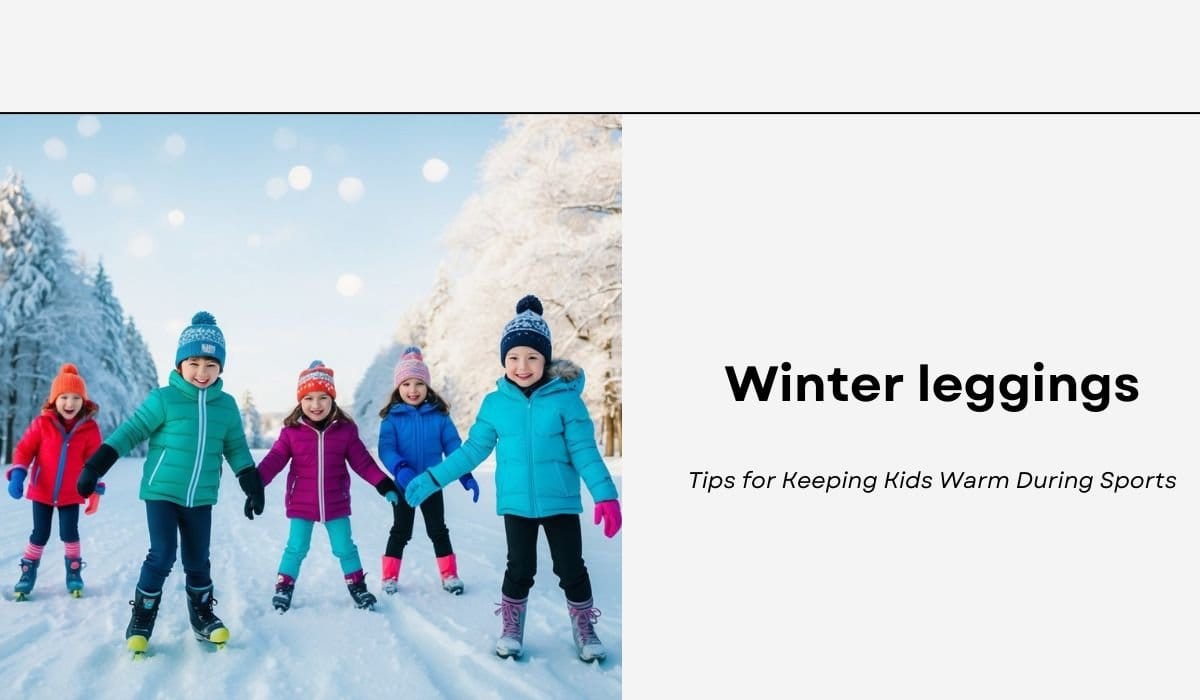Beyond Basic Layers: Smart Strategies for Active Kids’ Winter Comfort and Performance
Winter sports can be a blast for kids, but keeping them warm is crucial for their enjoyment and safety. Winter leggings are a key piece of gear for active children in cold weather. Layering winter leggings with other warm clothing helps trap heat and keep kids cosy during outdoor activities.
Choosing the right materials for winter leggings is important. Wool and synthetic fabrics like polyester are good options as they wick moisture away from the skin. This helps kids stay dry and warm even when they work up a sweat. Thick, insulated leggings or thermal base layers worn under regular trousers provide extra warmth without too much bulk.
Proper sizing is essential for winter leggings to work effectively. They should fit snugly but not restrict movement. Some parents buy leggings a bit larger so kids can wear them for more than one season. Rolling up the legs is an easy way to adjust the fit as children grow.
On This Page
Key Takeaways
- Layer winter leggings with other warm clothing for maximum heat retention
- Choose moisture-wicking materials like wool or synthetic fabrics for winter leggings
- Ensure proper fit for winter leggings to maintain warmth without restricting movement
Understanding the Importance of Layering
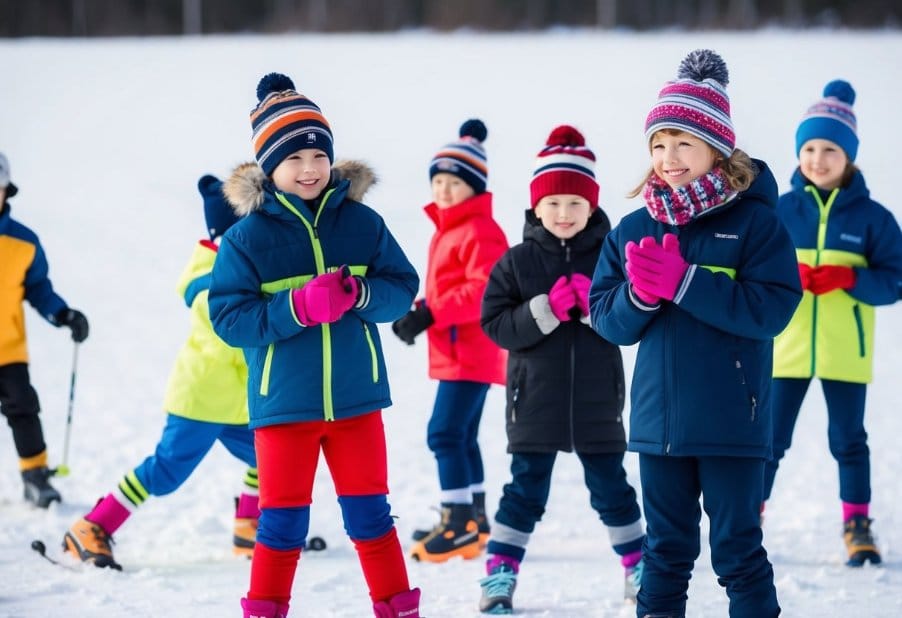
Layering is key for keeping kids warm during winter sports. It traps heat, allows moisture to escape, and gives kids options to adjust their warmth as needed.
Base Layer Essentials
The base layer sits next to the skin. It should be snug but not tight. Thermal tops and leggings made from materials like merino wool or synthetic fabrics work best. These fabrics wick sweat away from the body, keeping kids dry and warm.
Avoid cotton for base layers. It holds moisture and can make kids feel cold and damp. Look for long-sleeved tops and full-length leggings to cover as much skin as possible.
For very cold days, kids might need two base layers. A thin layer under a slightly thicker one can boost warmth without adding bulk.
Mid-Layer for Insulation
The mid-layer traps warm air between the base and outer layers. Fleece is a top choice for this layer. It’s light, warm, and dries quickly if it gets wet.
Wool jumpers are another good option. They keep kids warm even if they get damp. For extra cold days, a puffy jacket can serve as a mid-layer under a waterproof coat.
The mid-layer should be loose enough to allow movement but not so baggy that cold air can get in. Zip-up styles let kids easily adjust their temperature during activities.
Top Layer for Protection
The top layer shields kids from wind, rain, and snow. It should be waterproof and breathable. Look for jackets and trousers with taped seams to keep water out.
Features like adjustable cuffs, hoods, and waistbands help seal out cold air. Choose bright colours or reflective details for visibility in snowy conditions.
This layer needs to fit over the other layers comfortably. It should allow full range of motion for sports. Some kids might prefer separate jacket and trousers, while others like all-in-one snowsuits.
Selecting the Right Material
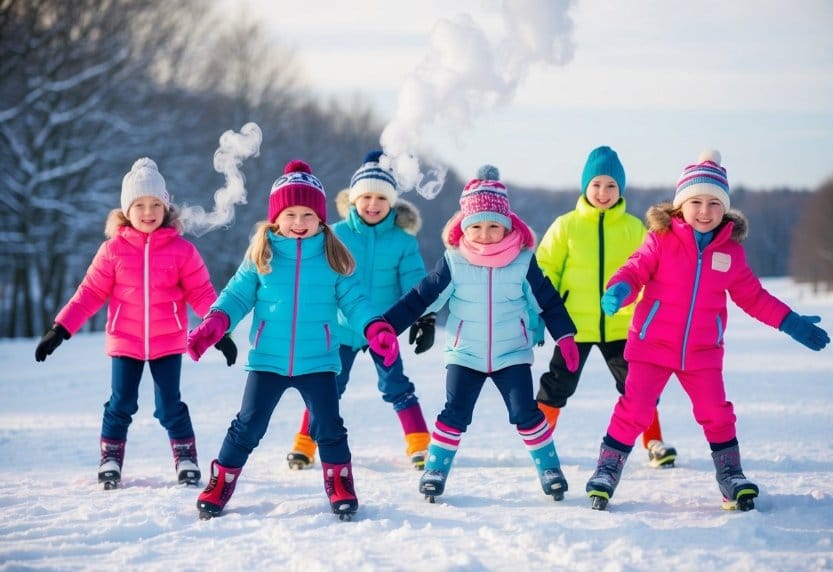
Choosing proper fabrics for winter leggings is key to keeping kids warm during sports. The right materials provide insulation and manage moisture to maintain comfort.
The Advantages of Merino Wool
Merino wool is an excellent choice for winter leggings. It’s soft, lightweight and naturally insulating. This fabric traps air to create warmth without bulk.
Merino wool wicks moisture away from the skin. This helps kids stay dry even when active. The material also resists odours, which is handy for sports.
Unlike some wools, merino is not itchy. This makes it comfortable for sensitive skin. Merino wool leggings regulate temperature well. They keep kids warm in cold weather but prevent overheating during exercise.
Polyester for Moisture Management
Polyester is another top pick for winter sports leggings. This synthetic fabric excels at moisture management. It moves sweat away from the body quickly.
Polyester dries fast, which helps kids avoid getting chilled by damp clothes. Many polyester leggings have a brushed or fleece lining for added warmth. This creates a cosy layer next to the skin.
The material is durable and holds its shape well. This makes polyester leggings a good choice for active kids. They resist wear and tear from sports activities.
Polyester is often blended with spandex. This adds stretch for better movement during sports. The fabric is easy to care for and doesn’t shrink in the wash.
Winter Leggings and Thermals
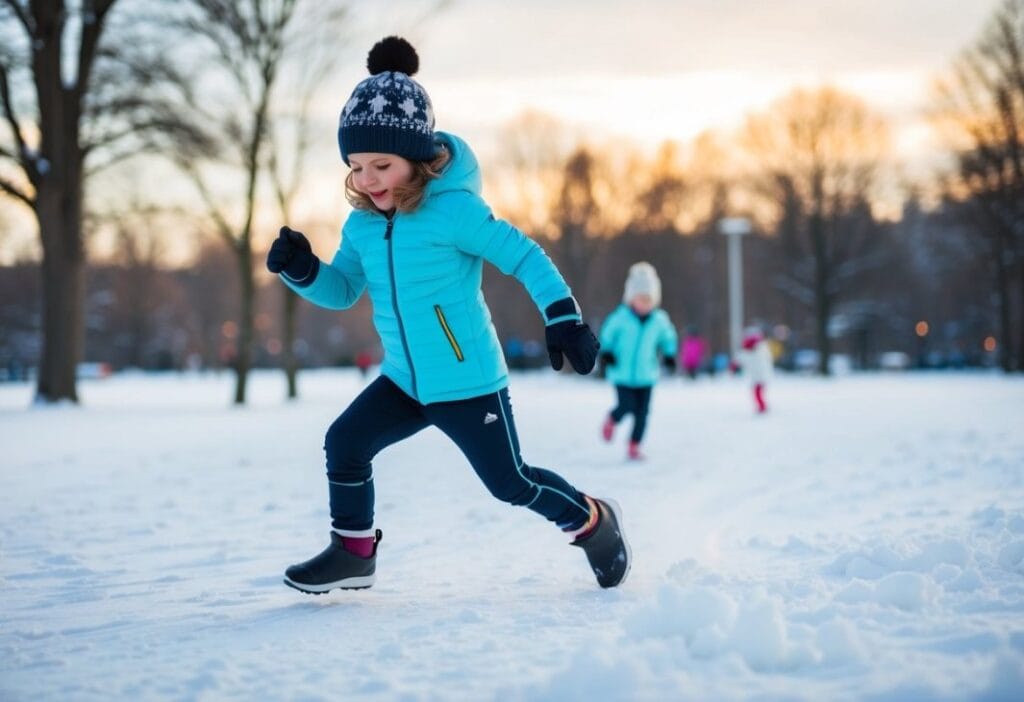
Winter leggings and thermals are essential for keeping kids warm during cold-weather sports. These specialised garments provide insulation and comfort to help children stay active outdoors.
Choosing Thermal Leggings
Thermal leggings are a great base layer for kids’ winter sports. They trap heat close to the body, keeping little legs toasty. Look for leggings made from moisture-wicking fabrics like merino wool or synthetic blends. These materials draw sweat away from the skin, preventing chills.
Fit is crucial for thermal leggings. They should be snug but not tight, allowing for easy movement. Many brands offer sizes specifically for children. Some thermal leggings have flatlock seams to reduce chafing during active play.
For extra warmth, consider double-layer thermal leggings. These have two layers of fabric for added insulation. Some styles also feature a soft, brushed interior for comfort against the skin.
Fleece Leggings for Extra Warmth
Fleece leggings offer a cosier option for very cold days. They’re thicker than thermal leggings and provide more insulation. Fleece traps air between its fibres, creating a warm barrier against the cold.
Look for fleece leggings made from high-quality polyester. This material is durable and keeps its shape after washing. Some fleece leggings have a water-resistant outer layer, which is handy for snowy conditions.
For active kids, choose fleece leggings with a bit of stretch. This allows for free movement during sports and play. Many styles have reinforced knees to withstand rough-and-tumble activities.
Some fleece leggings come with handy features like pockets. These are great for storing small items like hand warmers or keys.
Accessorising for Warmth and Safety
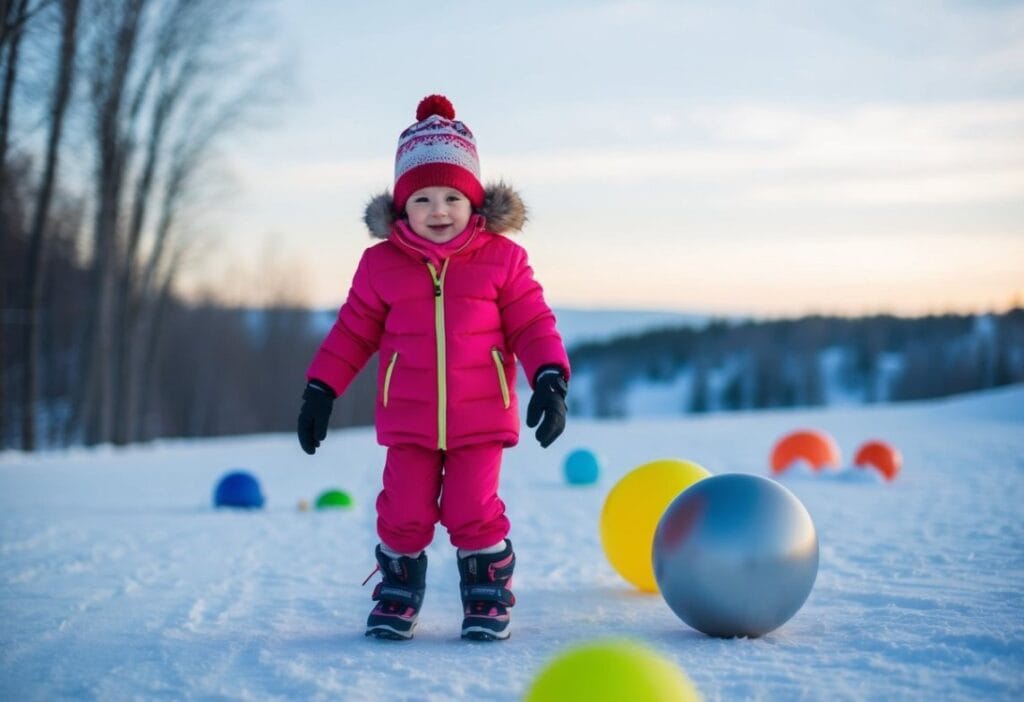
Proper accessories are vital for keeping kids warm and safe during winter sports. The right gear protects against cold and injuries while allowing children to enjoy outdoor activities.
The Necessity of Gloves
Gloves are crucial for protecting little hands from frostbite and cold-related injuries. Waterproof, insulated gloves are best for snow sports. Look for gloves with adjustable wrists to keep snow out.
For very cold days, mittens may be warmer than gloves. Some gloves have built-in hand warmers for extra cosiness.
Choose gloves with grips on the palms and fingers. This helps kids hold onto ski poles, snowboards, or sleds more easily.
Protective Goggles and Helmets
Goggles shield eyes from wind, snow, and harmful UV rays. They also improve visibility in bright or low-light conditions. Pick goggles that fit snugly over the helmet.
Helmets are a must for skiing, snowboarding, and sledding. They protect against head injuries from falls or collisions. Make sure the helmet fits properly and meets safety standards.
Some helmets have built-in goggle clips for convenience. Others have adjustable vents to regulate temperature.
Hats and Wool Socks
A warm hat prevents heat loss through the head. Choose a hat that covers the ears and stays in place during activity. Fleece or wool hats work well.
Some kids prefer ear warmers or headbands instead of full hats. These can work with helmets more easily.
Wool socks keep feet warm and dry. They wick moisture away from the skin, preventing blisters. Look for socks with extra cushioning in high-wear areas.
Consider getting socks with a blend of wool and synthetic fibres for durability. Pack spare socks in case feet get wet.
Practical Tips for Keeping Warm
Proper layering and weather-appropriate choices are key to keeping kids warm during winter sports. These strategies help maintain body heat while allowing comfort and freedom of movement.
Effective Layering Techniques
Start with a thin base layer made of moisture-wicking fabric. This layer should fit snugly against the skin to trap warm air. Merino wool or synthetic materials work well.
Add a middle insulating layer like a fleece jumper or vest. This layer traps heat and provides extra warmth. Choose breathable fabrics to prevent overheating during active play.
Top it off with a waterproof, windproof outer layer. This protects against snow, rain, and wind chill. Look for jackets and trousers with sealed seams and adjustable cuffs.
Don’t forget warm socks and waterproof boots. Layer thin socks under thicker ones for added insulation. Make sure boots are roomy enough to allow wiggle room for toes.
Weather Appropriate Choices
Check the forecast before heading out. Temperature, wind chill, and precipitation all affect clothing choices.
For very cold days, add extra insulation. Thermal leggings under trousers provide warmth without bulk. A neck gaiter or balaclava protects exposed skin on the face and neck.
On milder days, opt for lighter layers. Choose a thinner jacket or remove the middle layer if kids start to overheat. Zip vents in jackets help regulate temperature.
Always pack spare gloves and socks. Wet hands and feet get cold quickly. Having dry backups ensures kids stay comfortable throughout the day.
The Role of Leggings in Outdoor Sports
Leggings play a crucial part in keeping kids warm and comfortable during winter sports. They provide an essential base layer that helps regulate body temperature and allows for full range of motion.
Leggings for Snowboarding
Snowboarding requires specialised leggings to protect against cold and moisture. Thermal leggings made from synthetic materials or merino wool offer excellent insulation and wick away sweat. Look for options with reinforced knees and seat areas to prevent wear and tear from frequent falls.
Some snowboarding leggings feature built-in padding for extra protection. Fleece-lined varieties provide additional warmth on frigid days. Choose leggings with a snug fit to prevent bunching under snow trousers.
For all-day comfort, select leggings with flat seams to reduce chafing. Breathable fabrics help regulate temperature during active periods on the slopes.
Leggings for Sledding
Sledding calls for leggings that balance warmth with flexibility. Opt for thermal leggings made from stretchy materials like polyester and spandex blends. These allow kids to move freely while racing down hills.
Water-resistant leggings help keep children dry when sitting in snow. Look for options with reinforced seats for added durability. Fleece-lined leggings provide extra cosiness for long sledding sessions.
Choose leggings with a high waistband to prevent snow from sneaking in. Bright colours or reflective details increase visibility on overcast days. For maximum warmth, layer thermal leggings under waterproof trousers.
Understanding Cold Temperatures
Cold temperatures pose risks for kids playing sports outdoors in winter. Proper knowledge helps parents keep children safe and comfortable.
Recognising the Signs of Frostbite
Frostbite occurs when skin and tissues freeze due to extreme cold. Early signs include:
- Redness or pain in any skin area
- White or greyish-yellow skin
- Skin that feels unusually firm or waxy
- Numbness
Check exposed areas like fingers, toes, ears, cheeks, and nose regularly. If symptoms appear, move to a warm place immediately. Do not rub affected areas. Instead, gently warm them with body heat or lukewarm (not hot) water.
Adapting to Fluctuating Weather
Winter weather can change quickly. Be prepared by:
- Checking forecasts before heading out
- Dressing in layers that can be easily added or removed
- Bringing extra dry clothes to change into if needed
- Having a warm drink in a thermos
Adjust activities based on conditions. On very cold days, limit time outdoors and take frequent indoor breaks. When temperatures rise, remove layers to prevent overheating and sweating, which can lead to chills when the temperature drops again.
Maintenance and Care of Winter Sportswear
Proper care keeps winter sportswear in top shape. Regular cleaning and smart storage help leggings and other gear last longer. Good habits protect your investment and ensure kids stay warm and comfy.
Cleaning and Storing Leggings
Wash leggings after each use to remove sweat and dirt. Turn them inside out and use cold water on a gentle cycle. Avoid fabric softeners, which can damage moisture-wicking properties. Air dry or tumble dry on low heat.
Store leggings flat or rolled, not hanging. This prevents stretching. Keep them in a cool, dry place away from direct sunlight. Use breathable storage bags to protect from dust and moths.
For muddy or very dirty gear, pre-treat stains before washing. A soft brush can help remove dried mud. Don’t let dirt sit too long, as it can be harder to remove later.
Durability and Longevity
Quality winter sportswear can last for years with proper care. Look for reinforced seams and durable fabrics when buying. Avoid rough surfaces that can cause snags or tears.
Rotate between multiple pairs of leggings to reduce wear. Patch small holes quickly to prevent them from getting bigger. Use specialised products for waterproofing and insulation renewal on outer layers.
Check zips, elastic, and other closures often. Replace broken parts promptly to extend the life of the item. Teach kids to be gentle with their gear and to report any damage they notice.
Keep a repair kit handy for quick fixes. Include fabric patches, thread, and safety pins. Learning basic mending skills can save money and keep gear functional longer.
Size and Fit for Optimum Performance
Proper sizing and fit are crucial for kids’ winter leggings. Well-fitting gear keeps children warm and allows them to move freely during sports activities.
Ensuring a Snug Fit
Measure your child’s waist, hips, and inseam before buying leggings. Choose sizes that match these measurements closely. Look for leggings with elastic waistbands and stretchy fabrics for a comfortable fit.
Try leggings on over base layers to check the fit. The waistband should sit snugly without digging in or sliding down. Leggings should reach the ankles without bunching or riding up.
Some brands offer adjustable waistbands, which are great for growing kids. These allow you to fine-tune the fit as needed.
The Impact of Ill-Fitting Gear
Leggings that are too big can bunch up, causing discomfort and reducing warmth. Excess fabric may also get in the way during activities.
Tight leggings restrict movement and can be uncomfortable. They may also wear out faster due to extra stress on the fabric.
Poorly fitting gear can affect a child’s enjoyment of winter sports. It may lead to chafing, reduced performance, or reluctance to participate.
To avoid these issues, replace leggings as your child grows. Check the fit regularly, especially at the start of each winter season.
Ethical and Sustainable Choices
Choosing eco-friendly winter leggings for kids helps protect the environment and supports ethical brands. These options provide warmth and comfort while reducing environmental impact.
Eco-Friendly Materials
Sustainable leggings often use recycled materials like plastic bottles. This keeps waste out of landfills and oceans. Some brands make leggings from organic cotton, which uses less water and fewer chemicals to grow. Bamboo fabric is another good choice. It’s soft, warm, and grows quickly without pesticides.
Look for leggings made without harmful chemicals like PFAS. These can hurt kids’ health and the environment. Natural dyes are better than synthetic ones. They’re safer for skin and don’t pollute water when washed.
Supporting Ethical Brands
Ethical brands make sure workers get fair pay and good working conditions. They often have clear information about their factories and practices. Some use local production to reduce shipping and support nearby communities.
Look for brands that offer a wide range of sizes. This shows they care about including all body types. Many ethical brands also give back to charities or environmental causes. Some offer repair services or take-back programs to extend the life of their products.
When shopping, check for certifications like Fair Trade or GOTS (Global Organic Textile Standard). These show the brand meets high ethical and environmental standards.
Frequently Asked Questions
Keeping kids warm during winter sports requires the right gear and strategies. These common questions address key aspects of selecting and using winter sportswear for children.
What are the best materials for thermal leggings suitable for children’s sport?
Merino wool and synthetic blends like polyester or nylon work well for kids’ thermal leggings. These fabrics wick moisture and retain heat even when damp. Fleece-lined options add extra cosiness for very cold conditions.
Can base layers under sportswear effectively retain heat for young athletes?
Yes, base layers are very effective for young athletes. They trap a thin layer of warm air next to the skin. This helps regulate body temperature during activity. Base layers also move sweat away from the body to keep kids dry and comfortable.
What are the essential features to look for when choosing winter sportswear for children?
Look for water-resistant outer layers and breathable, moisture-wicking inner layers. Adjustable cuffs and hems help seal out cold air. Reflective details improve visibility in low light. Reinforced knees and seats add durability for active kids.
How can I ensure proper fit and comfort for my child when selecting sports leggings for cold weather?
Choose leggings with a bit of stretch for ease of movement. Make sure the waistband is snug but not tight. Check that the length reaches the ankles without bunching. Flat seams reduce chafing. Try them on with the socks and shoes your child will wear for sports.
Are there specific washing instructions for maintaining the warmth properties of kids’ sports leggings?
Follow the care label instructions carefully. Most thermal leggings need gentle washing in cool water. Avoid fabric softeners, which can reduce moisture-wicking properties. Air dry or tumble dry on low heat to protect the fibres and maintain insulation.
What advice is there for layering clothing to maintain my child’s warmth during outdoor sports sessions in winter?
Start with a thin, moisture-wicking base layer. Add an insulating middle layer like fleece. Top with a waterproof, breathable outer layer. Adjust layers based on activity level and weather. Don’t forget warm socks, gloves, and a hat to prevent heat loss.
Related Post: Winter Leggings for Active Kids: Cosy and Durable Options for Outdoor Play

